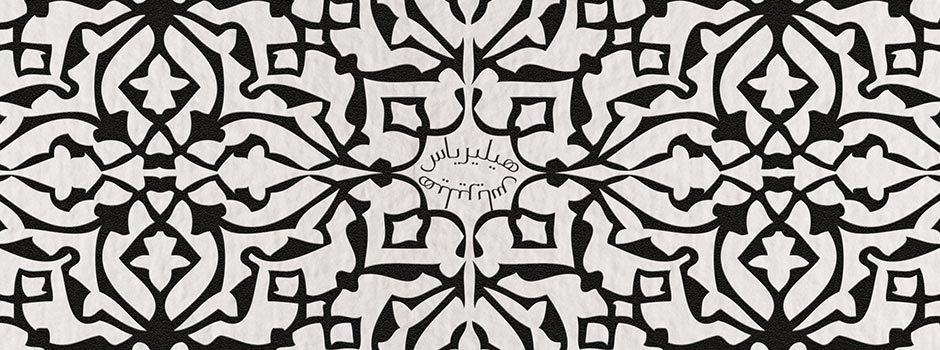
AN INTERVIEW WITH EGYPTIAN CURATOR ENAS ELKORASHY The Made In..Gallery, Venice
Aug 01, 2016 Interview

The Made In…Art Gallery in Venice opened its doors on October 17th 2015 with an exhibit by Venetian painter Franco Renzulli, known for his canvases exuding light and melding colours, signs and figures. Egyptian artist Enas Elkorashy, its owner and manager, established the gallery as a showcase for global art and as a space to enable collaborations with artists and institutions internationally, particularly with the Middle East. Elkorashy received a degree in Fine Arts in Egypt before moving to Italy in 2008 where she undertook studies in fashion design. Her curatorial debut began in 2013 when she co-curated with Daniella Bacigalupo a show of contemporary Egyptian art in Venice held at the same time as the Biennale. This was followed the next year by her organizing of the first My Home Gallery event in Cairo in which artists open up their studios to visitors and tourists.
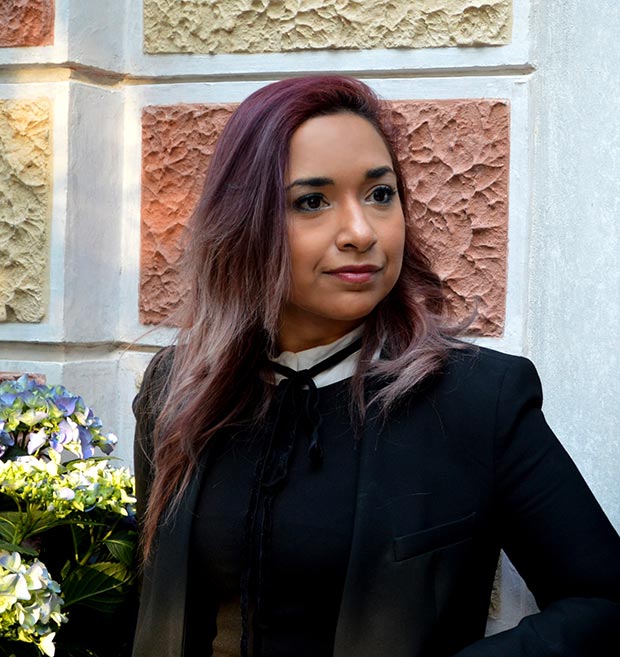 Egyptian artist and curator Enas Elkorashy / Courtesy of Enas Elkorashy
Egyptian artist and curator Enas Elkorashy / Courtesy of Enas Elkorashy
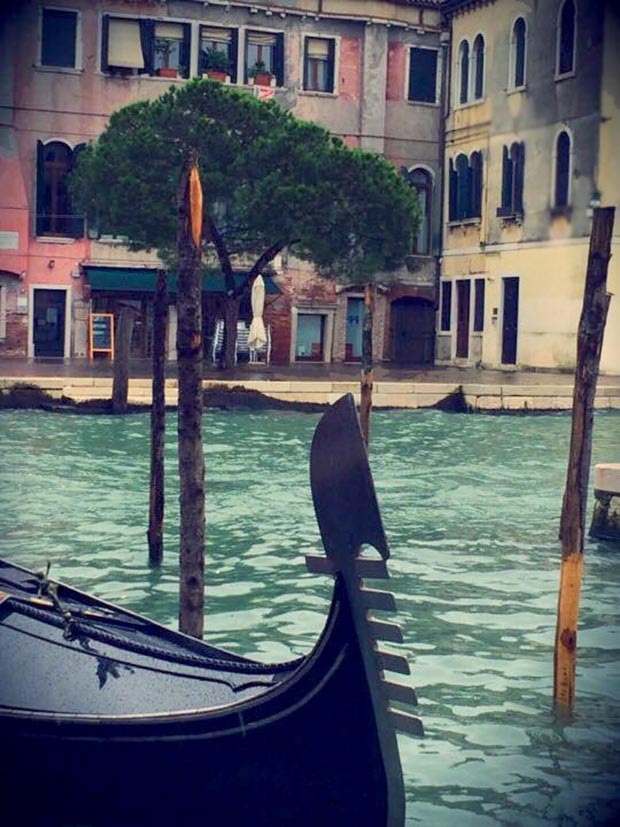 The Made In…Art Gallery in Venice / Courtesy of The Made In…Art Gallery
The Made In…Art Gallery in Venice / Courtesy of The Made In…Art Gallery
I chose Franco because I wanted to start my gallery with a Venetian artist to reference the city in which I live and in which I decided to open my gallery. I didn’t choose him because he travelled worldwide or lived and worked in many countries like Africa, the United States or the Czech Republic. Opening with one of the most important Italian Venetian artists meant for me a certificate of quality for the gallery. People who didn’t know me could trust me and trust my gallery because it’s not easy to get an important artist like Franco Renzulli to trust a new gallery and a young curator, especially as, in the last years, he hasn’t exhibited often at all.
I’ve known Franco since 2012; I visit him sometimes and he always gives me advice when I’m in an ‘art crisis’. He invited me to work in his studio in 2013; it was a great honour for me to work in there.
 Franco Renzulli, a veteran Venetian painter / Courtesy of Made In..Gallery
Franco Renzulli, a veteran Venetian painter / Courtesy of Made In..Gallery
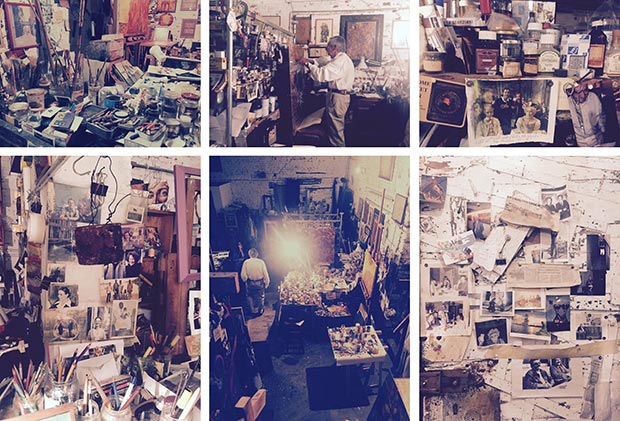 Franco Renzulli, a veteran Venetian painter in his studio / Courtesy of Made In..Gallery
Franco Renzulli, a veteran Venetian painter in his studio / Courtesy of Made In..Gallery
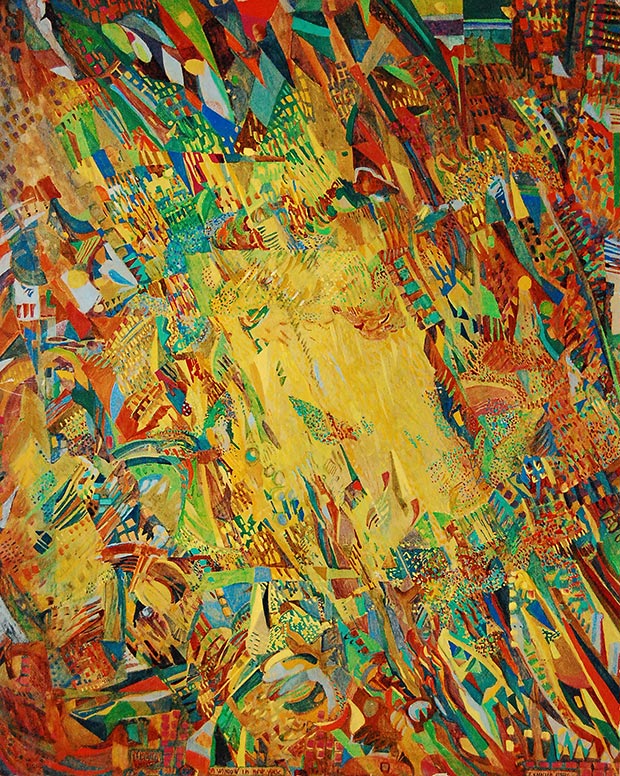 Franco Renzulli, Window in New York, mixed media on canvas, 100x80 cm, New York, 1988 / Courtesy of Made In..Gallery
Franco Renzulli, Window in New York, mixed media on canvas, 100x80 cm, New York, 1988 / Courtesy of Made In..Gallery
_mixed_media_on_canvas_100x76cm_New_York_1990.jpg) Franco Renzulli, Twin towers + 3 potatoes (from the window in Harisson) , mixed media on canvas, 100x76 cm, New York, 1990 / Courtesy of Made In..Gallery
Franco Renzulli, Twin towers + 3 potatoes (from the window in Harisson) , mixed media on canvas, 100x76 cm, New York, 1990 / Courtesy of Made In..Gallery
It is for many reasons including, of course, the misunderstanding between East and West. The media gives a weird image about us and I just try to correct and fix that image as I can through art. Some art clearly reflects the cultures of the Middle East and some shows that Middle Eastern artists work in a similar fashion as in the West: they—we—are not different. And both types of work create a positive change of the image of the Middle East in Italy. However, the visibility of Middle Eastern art is still very low in Italy and Venice. The Venice Biennale is not enough!
When I exhibited some Egyptian painters, gallery visitors were shocked to see "normal" art. Most of them told me how good it was to see something beautiful from Egypt and how they are used to seeing only the dark side of Egypt in the media. This disturbed me a lot as I hadn’t realized power and bad effect of the media on people. It’s like blinding them. This is why I want to bring the art of the Middle East to Europe and the whole world.
The aim of the gallery means that I work collaboratively and I believe collaborations create the best success. I collaborate with the Casa dei Carraresi Museum in Treviso, Italy and I have collaborated with the Picasso Art Gallery in Cairo for an exhibition this year in which we showed Egyptian painter Samir Fouad’s canvases at my gallery.
 Samir Fouad, Untitled, oil on canvas, 100x80 cm, 2014 / Courtesy of Made In..Gallery
Samir Fouad, Untitled, oil on canvas, 100x80 cm, 2014 / Courtesy of Made In..Gallery
Actually, the show emerged as part of my ongoing collaboration with the Casa dei Carraresi Museum, with curator Daniel Buso in particular, to organize Middle Eastern exhibitions at the museum. Then, in 2016, Daniel Buso asked me to co-curate an exhibition about the Middle East, presenting viewpoints from both western and Middle Eastern artists on the Middle East. I think it was perfect timing in light of the current political situation; people’s curiosity about the people about the Middle East made the show a success. We chose the title 'Breakfast in Beirut', the name of film by Lebanese Kuwaiti filmmaker Farrah Al Hashem, because this film presents the love-hate relationship between us and our country or city, an ambiguous crisis-like feeling that forms one of the reasons for emigration. This feeling is especially present in the Middle East because of the current political and economic situation in most countries, so the title evokes, indirectly, the states of mind that leads to leaving one’s home.
The exhibition space has two floors. On the first floor, we exhibited western and Middle Eastern artists whose artworks criticize the political situation in the Middle East. However, on the second floor, we only showed Middle Eastern artists whose art was not engaged with political matters. This part of the show actually confused the visitors more; many visitors didn’t understand why Middle Eastern artists could make art that is neither about politics or war! I expected this reaction and I did it on purpose because I like to shock people so they can see that we are just normal people, that’s it. During the art festival there were collateral events as well, like an Iranian concert, a screening of Afghan films, book presentation and so on. Now we are seeking to organize 'Breakfast in Beirut 2' in another city or country.
 Exhibition Breakfast in Beirut / Courtesy of Made In..Gallery
Exhibition Breakfast in Beirut / Courtesy of Made In..Gallery
For the 'Identity' show, I selected 20 artists from Italy, Egypt, Saudi Arabia, Iran and the United States. This theme is extremely important for me, because in the events I curate, I exhibit identities. It’s all about identities, which, for me, are best explored and seen through art. For the present show, the theme was open and therefore the artists address identity freely and as they like. This is why you see many takes on it; the artists in the show explore language, memory, gender, the soul of Venice or Cairo, new ways of seeing, autobiography, identity crises or imaginary identities.
_silkscreen_print_on_paper_2012.jpg) Heba Abed, Scotoma (Lost in transliteration), silkscreen on canvas, 70x70 cm, 2012 / Courtesy of Made In..Gallery
Heba Abed, Scotoma (Lost in transliteration), silkscreen on canvas, 70x70 cm, 2012 / Courtesy of Made In..Gallery
_silkscreen_print_on_paper_2012_70x70cm.jpg) Heba Abed, Scotoma (Lost in transliteration), silkscreen on canvas, 70x70 cm, 2012 / Courtesy of Made In..Gallery
Heba Abed, Scotoma (Lost in transliteration), silkscreen on canvas, 70x70 cm, 2012 / Courtesy of Made In..Gallery
I think destiny put me on the way of curating. I never thought of it originally; I just wanted to be an artist. In 2012,when I was planning my first solo exhibition scheduled for 2013, I asked the curator Daniella Bacigalupo to curate the show. After a while, however, I felt that I wasn’t yet ready for a solo show and so I suggested to Daniella that she curate, instead, the first Egyptian group exhibition in Venice. This was the starting point of everything that followed.
Because Daniella Bacigalupo doesn’t speak English, I had to communicate with the artists, interview them and translate the critical texts and articles about them. I became involved in the organization as well. In the end, I was involved in every aspect while, at the beginning, I was just one of the artists to be exhibited. The exhibition met great success in Venice and Egypt and I become well-known thanks to it, with people complimenting me a lot, but as a curator not as an artist. Actually, this put me in a panic and made me confused. I started to wonder whether I was an artist or a curator! I loved being an artist, but I also loved making success for other artists. It was and is a great pleasure for me, especially as I saw that exhibitions could change the visitors’ preconceptions about Egypt. The show was therefore a double success. So I decided to continue curating international exhibitions, whether Middle Eastern events and art in Europe or European events and art in the Middle East.
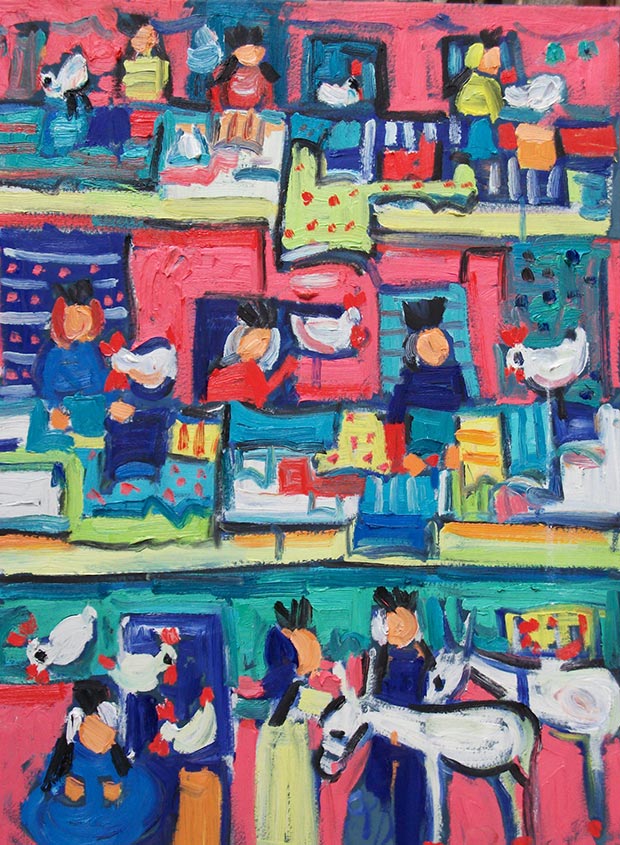 Miriam Hathout, Autentiche donne egiziane, oil on canvas, 2016 / Courtesy of Made In..Gallery
Miriam Hathout, Autentiche donne egiziane, oil on canvas, 2016 / Courtesy of Made In..Gallery
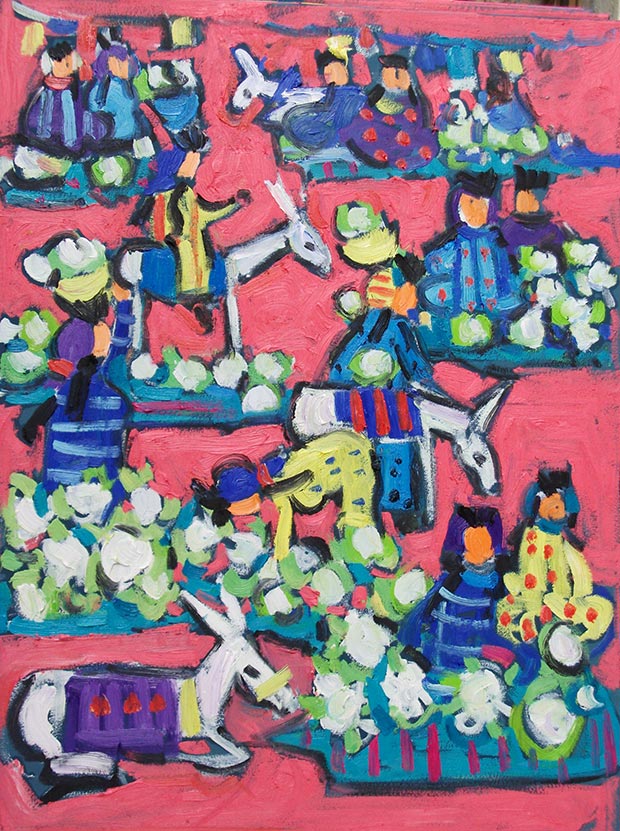 Miriam Hathout, Autentiche donne egiziane, oil on canvas, 2016, 60x80 cm / Courtesy of Made In..Gallery
Miriam Hathout, Autentiche donne egiziane, oil on canvas, 2016, 60x80 cm / Courtesy of Made In..Gallery
After finishing my studies in fashion design, I decided to move to Saudi Arabia to live and work. It is my origin as my grandfather is Saudi, even if he was born in Egypt where I grew up. I had always been curious and still am, until now, about how my life would have been different had I been born in Saudi Arabia and not Egypt. I accepted a teaching offer there but never went because the plan quickly changed. One day, I passed in front of a place for sale in Venice. The location was so good that I went to ask about it and visited it. I really liked it and saw that could it could easily be transformed into a gallery. Everything was done in one week as if destiny was pushing me to curate again.
I don’t like, however, to define myself as a gallery dealer because I am a curator. I fund this gallery to have a fixed place for the events I curate, plus to organize the events I curate in other venues. But I am flexible as well and am open to other curators and galleries to organize exhibitions at my space.
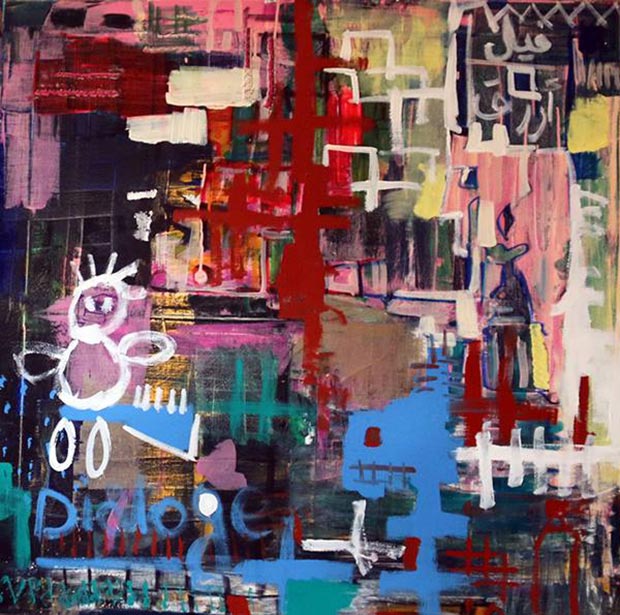 Aya Elfallah, Elephant dialogue, mixed media on canvas, 120x120 cm, 2014 / Courtesy of Made In..Gallery
Aya Elfallah, Elephant dialogue, mixed media on canvas, 120x120 cm, 2014 / Courtesy of Made In..Gallery
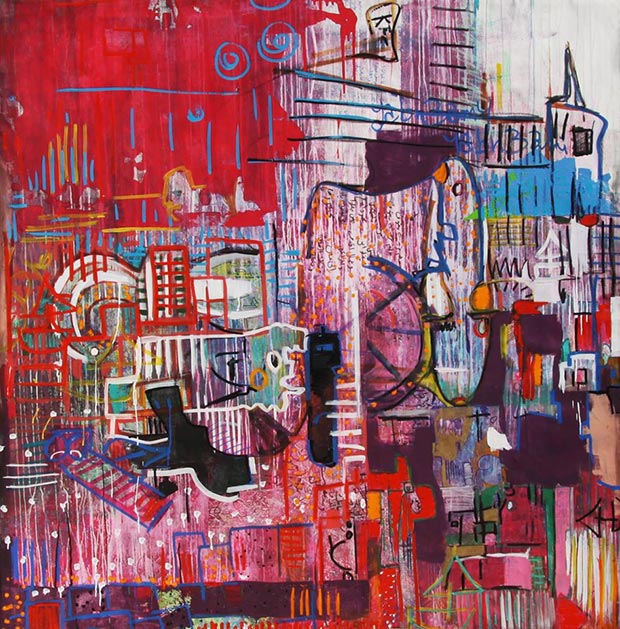 Aya Elfallah, The red city, mixed media on canavs, 2x2m, 2014
Aya Elfallah, The red city, mixed media on canavs, 2x2m, 2014
My dream show would be about the wars in the Middle East, and, first of all, in Syria. Europeans are so careless and negative about them. Not that long ago, there was a war and Europeans escaped everywhere, including to the Middle East. But still now, they don’t see Middle Easterners as humans. Of course, the media plays a terrible role in the dehumanisation. They don’t seem to care if the refugees die or if their lives are completely destroyed!
I have several projects about this theme. Starting in next September, I have a project about Syrian refugee kids entitled 'I Draw To Live'. At the end of July, I’m going to Beirut to meet some Syrian children for that project. I also hope that I can establish more collaborations with Middle Eastern galleries for a big exhibition about the wars in the Middle East that will travel around Europe with all income going to the refugees.
Comments
Add a comment